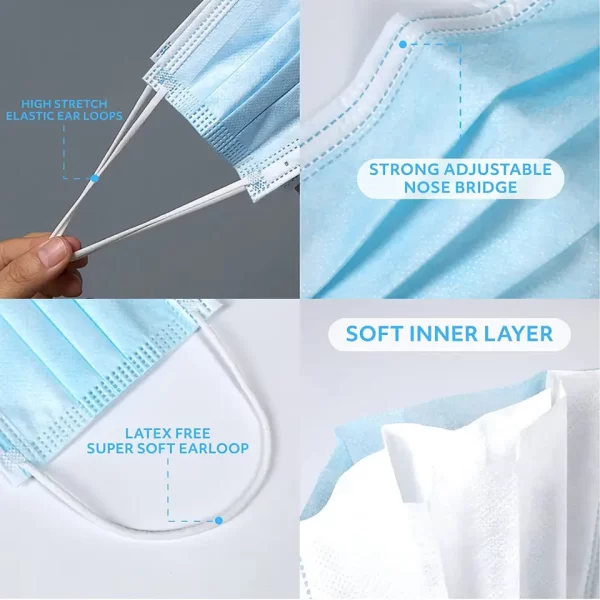Introduction
With the dawn of the global pandemic, face masks have become a ubiquitous symbol of our collective efforts to curb the spread of airborne diseases. Among them, 3-ply face masks, known for their layered protection, have gained significant popularity. However, not all masks are created equal. This comprehensive comparison and analysis of 3-ply face masks will empower you to make informed decisions when considering your face mask options.
Understanding the Structure of 3-Ply Face Masks
A 3-ply face mask is ingeniously structured with three different layers, each serving a unique purpose. The outer layer is hydrophobic, meaning it repels water, blood, and bodily fluids. The middle layer acts as a high-level filter, trapping bacteria, while the inner layer absorbs the moisture exhaled from the wearer’s breath. This combination results in a mask that not only keeps the wearer safe but also those around them.
Comprehensive Comparative Evaluation of 3-Ply Face Masks
Material Quality
A key point of comparison for 3-ply face masks is the quality of the materials used. Superior masks typically use non-woven, high-quality, medical-grade fabric. These materials offer enhanced durability, ensuring the mask maintains its integrity and continues to provide a barrier against pathogens for the duration of its use. Lower quality materials may compromise this barrier, rendering the mask less effective.
Filtration Efficiency
The ability to filter out harmful particles is a critical parameter when assessing the effectiveness of 3-ply face masks. The melt-blown filter layer in the middle is the mask’s heart, capturing microscopic contaminants. A higher filtration efficiency, ideally 95% or more, ensures better protection. However, variations in design and the melt-blown layer’s quality mean that not all masks meet this threshold.
Breathability
Breathability is an important yet often overlooked aspect of a mask’s performance. A mask that restricts airflow can cause discomfort, leading the wearer to adjust the mask frequently or remove it prematurely. High breathability ensures the mask can be worn for extended periods without discomfort. However, a balance between breathability and filtration efficiency is essential, as high breathability can sometimes compromise filtration efficiency.
Fit and Comfort
The physical design and fit of a 3-ply face mask greatly influence its effectiveness. A poorly fitting mask can allow airborne particles to bypass the mask entirely, reducing its protective capabilities. When considering different 3-ply masks, look for features like adjustable nose wires and ear loops. These features allow for a better fit, ensuring the mask effectively seals around the wearer’s face.
Sustainability
The rise in disposable 3-ply face mask usage has led to concerns about their environmental impact. Consequently, some companies have started producing biodegradable or reusable 3-ply masks. When comparing masks, consider the sustainability of the mask in question and the manufacturer’s environmental policies.
Cost
Given the ongoing need for face masks, cost-effectiveness is a key consideration for many individuals and organizations. While higher-grade, premium 3-ply masks often offer superior protection, they may not be viable for all budgets. Fortunately, there are affordable options that still provide a sufficient level of safety and comfort.
Importance of Certifications and Standards
In the world of 3-ply face masks, certifications and safety standards are critical. Masks certified by health and safety organizations are tested to ensure they meet specific filtration, breathability, and fluid resistance standards. For instance, look for masks that meet ASTM (American Society for Testing and Materials) Level 1, 2, or 3, or have a CE mark, which indicates compliance with European safety standards. This is an added assurance of the mask’s quality and effectiveness.
The Real-World Impact of 3-Ply Masks
Numerous studies have been conducted to assess the real-world impact of 3-ply masks. One such notable comparative study published in The Lancet demonstrated that 3-ply masks could significantly reduce transmission risks compared to single or double-layered masks. This research and similar studies provide evidence-based support for the effectiveness of 3-ply masks in preventing the spread of airborne diseases.
Conclusion
In our global fight against airborne diseases, 3-ply face masks play an undeniably crucial role. However, when selecting a mask, one must consider various factors such as material quality, filtration efficiency, breathability, fit and comfort, sustainability, cost, and certifications. The most effective mask is the one that balances these factors to meet your specific needs and is worn correctly and consistently.
Through careful comparison and thoughtful consideration, it’s possible to find a 3-ply mask that offers protection, comfort, and affordability. As we continue to navigate these challenging times, making informed decisions about our protective measures will contribute to a safer, healthier world.
Please visit our website for more product details https://medposnonwoven.com/product/3-ply-civil-face-mask-with-earloop/

